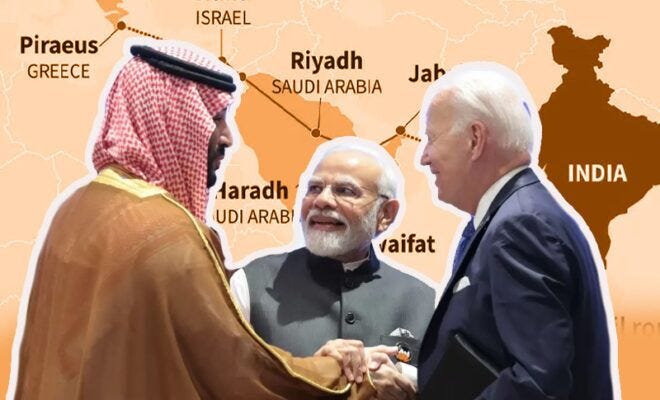1. Abstract
This paper intends to analyze the prospect of the “India-Middle East-Europe Economic Corridor (IMEC)”. It is an ambitious project aimed at creating a cost-effective trade and transport corridor including both railways and waterways. The paper discusses the scope and the geopolitical nitty-gritty that will hold significance in its implementation. As the paper unfolds, it addresses the roadblocks and pertinent questions that have arisen in global news. The paper also strives to view this mega project from India’s lens. Finally, the paper also suggests the way forward for IMEC.
2. Introduction
Prime Minister of India Mr. Narendra Modi and President of the USA Mr. Joe Biden co-chaired a special event on the Partnership for Global Infrastructure and Investment (PGII) and India-Middle East-Europe Economic Corridor (IMEC), on 9 September 2023 on the sidelines of the G20 Summit in New Delhi. The event aimed at unlocking greater investment for infrastructure development and strengthening connectivity in its various dimensions between India, the Middle East, and Europe. Leaders of the European Union, France, Germany, Italy, Mauritius, UAE, and Saudi Arabia, as well as the World Bank, participated in the event. The IMEC is expected to stimulate economic development through enhanced connectivity.
3. Objective of the project
As conceived by the participating countries, it aims to create two corridors, linking India to the Middle East in the Arabian Gulf and further connecting the Gulf to Europe. The aim is to develop a railway network to facilitate the seamless transmission of goods and services across India, Israel, UAE, Saudi Arabia, and finally Europe. This brainchild of America is increasingly using multilateral bodies such as the QUAD ( a grouping of India, Japan, the US, and Australia) and I2U2 ( India, Israel, UAE, and the US) to maintain its influence on the shifting sands of geopolitics. It is worth mentioning that all four I2U2 nations are participants in the IMEC. These four nations are meeting at regular intervals to cooperate on key areas of secure supply chains, countering terrorism, and solutions to climate change.
The white house fact sheet released post the launch of IMEC read “The United States and our partners intend to link both continents to commercial hubs and facilitate the development and export of clean energy; lay undersea cables and link energy grids and telecommunication lines to expand reliable access to electricity; enable innovation of advanced clean energy technology; and connect communities to secure and stable Internet. Across the corridor, we envision driving existing trade and manufacturing and strengthening food security and supply chains.” The white house also committed to increasing investments in regional investment initiatives such as the IMEC.
It aims to connect India, the Middle East, and Europe through an extensive transportation network that includes rail, road, and maritime routes. It seeks to increase economic cohesion, cut expenses, improve transportation efficiency, create jobs, and reduce greenhouse gas (GHG) emissions. By promoting trade and connectivity, it has the potential to revolutionize the integration of Asia, Europe, and the Middle East.
4. History
The Partnership for Global Infrastructure Investment (PGII), was formed as an alternative to the BRI in 2022. It seeks to finance infrastructure projects in developing nations through public and private capital, including this programme. In response to worries about China’s BRI, which involves giving loans and infrastructure development in numerous nations, PGII was created. According to critics, these ventures frequently resulted in unmanageable debts and geopolitical influence. Through a combination of public and private investments, the PGII, which consists of the G7 countries and the EU, seeks to finance infrastructure projects in developing countries. It places a strong emphasis on openness, the creation of climate-resilient infrastructure, gender equality, and health infrastructure. The PGII, in contrast to the BRI, emphasizes cooperation between democracies and strives to give loans rather than charity.
5. A new epoch of connectivity?
The new corridor is being popularized by many as the “New Silk Road”. “The Silk Road was a network of Eurasian trade routes active from the second century BCE until the mid-15th century. Spanning over 6,400 kilometers (4,000 miles), it was central in facilitating economic, cultural, political, and religious interactions between the East and West. The name “Silk Road”, first coined in the late 19th century, has fallen into disuse among some modern historians in favor of Silk Routes, because it more accurately describes the intricate web of land and sea routes connecting Central, East, South, Southeast, and West Asia, East Africa, and Southern Europe.”
Click Here To Download The Paper


📌Analysis of Bills and Acts
📌 Summary of Reports from Government Agencies
📌 Analysis of Election Manifestos

